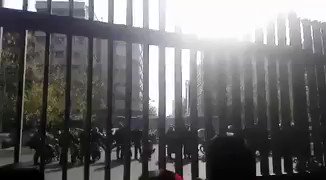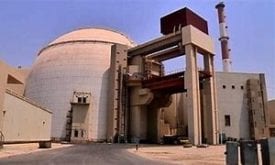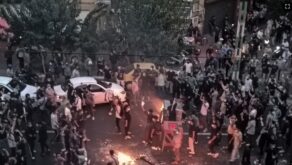Al-Arabia – With a new wave of US sanctions just around the corner, the regime ruling Iran is in deep waters as domestic and international pressures escalate. To add insult to injury for the clerics in Tehran, public discontent is increasing and people from all of life across Iran are demanding regime change.
Strikes and protests have continued in relentless waves across the country, especially following the December/January uprising. This movement, enjoying vast support in Iran’s society, is shaking the very pillars of this regime.
Plundering the Iranian people for 39 years and counting, the United States withdrawing from the 2015 Iran nuclear deal is further depriving Tehran of the funds it desperately needs to continue fueling its domestic crackdown machine and belligerence aimed at foreign targets.
The clerical regime has played all its cards and the Iranian people will no longer fall for any further deceptive plots.
Reform: A story of the past
In a frantic attempt, the Iranian regime is busy with a diplomatic campaign seeking the support of other Iran nuclear deal partners – the document formally known as the Joint Comprehensive Plan of Action (JCPOA) – being Germany, France, the United Kingdom, Russia and China.
These measures have failed to render any tangible results for the Iranian regime, especially considering the fact that the country’s currency, the rial, has plunged and lost more than 60 percent of its value since April alone. Inflation is skyrocketing and even basic necessities are running scarce, all due to the regime’s mismanagement.
In the West, pundits argue Iranians would “rally around the flag” and provide more power to the regime’s hardliners in the face of US hostility. Following US President Donald Trump’s withdrawal from the JCPOA, Iranians are actually understanding how regime leaders are the party to blame. They have also put an end to any “rally” claim raised by foreigners obviously lacking the necessary knowledge to correctly analyze Iran’s current powder keg society.
For many “experts” it will be hard to admit that the on-the-ground reality of Iran’s fast developing political landscape is far too complex to easily evaluate the recitation of events through the canvas of “reformists” against the hardcore “principalists.” The protests and all out uprising since late December 2017 have proven once for all that the so-called reformists in Iran have failed to render any change deemed positive in the past two decades.
 A military truck carrying a missile and a picture of Iran’s Supreme Leader Ayatollah Ali Khamenei is seen during a parade marking the anniversary of the Iran-Iraq war (1980-88) in Tehran, in this September 22, 2015 file photo. (Reuters)
A military truck carrying a missile and a picture of Iran’s Supreme Leader Ayatollah Ali Khamenei is seen during a parade marking the anniversary of the Iran-Iraq war (1980-88) in Tehran, in this September 22, 2015 file photo. (Reuters)
Iran’s “reformists,” dating back to when the now dead former president Ali Akbar Hashemi Rafsanjanicame to power in 1989, have been on a specific mission never mentioned or explained clearly in western mainstream media: preserving the Iranian regime in power by promising – and very rarely implementing – minor “reforms.”
The protests since December have caught the Iranian regime, and the world over, by surprise. And the so-called reformists in Iran have received their message: Your time is up. The Iranian people are increasingly realizing that the “reformists” in Iran are no different from the hardliners sitting on the throne and having the last word on all major issues.
The “Reformists, principalists, game over” slogan put an end to the “reform” mirage in Iran. A list of Iranian “reformists” are showing their true colors by not standing alongside the people, losing the nation’s trust as a result. Various remarks include:
• Massoumeh Ebtekar, Iran’s vice president for women’s affairs, accused the protesters of being directed by elements outside of Iran;
• Abbas Abdi, dubbed as a “reformist leader,” described the recent protests as “uncalculated and irrational;”
• the Association of Combatant Clerics, an entity chaired by former Reformist president Mohammad Khatami, who claimed “opportunists and troublemakers have exploited” them.
Furthermore, it’s good to know that Mir Hossein Mousavi, also described as a “reformist leader” in Iran’s political spectrum, was this regime’s prime minister during the 8-year long Iran-Iraq War, continuously promoting the horrific initiative.
Mousavi also recently admitted of his knowledge regarding the 1988 massacre of over 30,000 political prisoners, mostly members and supporters of the main Iranian opposition, the People’s Mojahedin Organization of Iran (PMOI/MEK).
Mir Mahmoud Mousavi, brother to the former prime minister and a former diplomat for this regime, has recently voiced utter disappointment in Iran’s “reformists,” saying they lack the ability to do anything more than what they have shown in the past two decades.
Which in itself has been anything but meaningful.
#BreakingNews
Dec 30 – #Tehran University, #Iran
College students chanting: “Reformists, Principalists, GAME OVER”#IranProtests #تظاهرات_سراسرى
Evolving landscape
What we are witnessing in the protests spreading across Iran during the past ten months have been a wave launched by the largely poor and rural branches of Iran’s society. Setting aside those ruling the country and enjoying ties to the regime, the economic crisis engulfing Iran is having a deep impact on nearly every household.
Iranian President Hassan Rouhani, another “reformist,” had promised to realize economic prosperity following the JCPOA. However, more billions were funneled to fuel the clerical regime’s support for Bashar Assad in Syria, Houthi militias in Yemen, the Lebanese Hezbollah, sectarian militias in Iraq, further development of ballistic missiles and … the list goes on.
More reason why over 140 cities erupted in major revolt back in December 2017, far before Trump imposed sanctions. It is quite telling that from that turn of events, the clerical regime’s bubble of enjoying the support of the lower, dispossessed class in Iran, has burst.
All the while, Iran’s middle class – or whatever is left of it as 80 percent of the population lives in poverty – is also seen taking to the streets and expressing their anger very publicly on the fact that this regime has failed to deliver socially and economically.
With #Iran‘s regime suffering from a variety of crises, the ongoing protests & strikes are lesser discussed in the media.
My @AlArabiya_Eng take digs into the highly important #IranProtests.https://english.alarabiya.net/en/features/2018/10/01/Iran-Understanding-the-truck-drivers-nationwide-strike.html …Iran: Understanding the truck drivers’ nationwide strike
From September 23 we have been witnessing a new round of strikes launched by truck drivers
english.alarabiya.net
Stepping up the tempo
Iran’s regime has been known to quell public dissent for forty years. The significant factor in this round of ongoing protests is the organized nature of such movements, seen most recently in the truck drivers’ nationwide strike that has now entered its third week and spreading to over 310 cities.
Time and again senior Iranian regime officials are voicing their utter concerns about the Iranian opposition PMOI/MEK, and specifically their “Resistance Units” network inside the country, playing the decisive role in the ongoing uprising.
The Iranian people have shown in the past 39 and some years, with major episodes in 1999, 2009 and the ongoing uprising, that they will not tolerate this regime. As the regime loses the support of a destructive appeasement policy practiced by the West, especially during the Obama years, it grows gradually weaker in the face of an increasingly restive nation that is demanding and will realize sweeping changes through an all-out revolution in the near future.
 Shabtabnews In this dark night, I have lost my way – Arise from a corner, oh you the star of guidance.
Shabtabnews In this dark night, I have lost my way – Arise from a corner, oh you the star of guidance.




